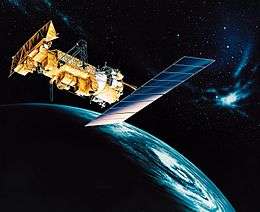NOAA-B
NOAA-B[3] was a spacecraft in the TIROS-N series launched by NASA on 29 May 1980. Intended for a Sun-synchronous orbit, the spacecraft entered a lower, elliptical orbit due to a launch vehicle malfunction resulting in a failed mission. Had the launch been successful it would have been designated NOAA-7.[4]
| Mission type | Meteorology |
|---|---|
| Operator | NOAA |
| COSPAR ID | 1980-043A |
| SATCAT no. | 11819 |
| Mission duration | Planned: 2 years Launch failure |
| Spacecraft properties | |
| Bus | TIROS-N[1] |
| Manufacturer | RCA Astro Electronics[2] |
| Launch mass | 1,405 kg (3,097 lb)[1] |
| Start of mission | |
| Launch date | 29 May 1980, 10:53 UTC[3] |
| Rocket | Atlas F 19F[2] |
| Launch site | Vandenberg SLC-3W[2] |
| End of mission | |
| Disposal | Orbital decay |
| Decay date | 3 May 1981[3] |
| Orbital parameters | |
| Reference system | Geocentric |
| Regime | Low Earth |
| Eccentricity | 0.08142 |
| Perigee altitude | 273 km (170 mi) |
| Apogee altitude | 1,453 km (903 mi) |
| Inclination | 92.3° |
| Period | 102.2 minutes |
| Epoch | 28 May 1980, 20:00:00 UTC[3] |
TIROS-N | |
Science objectives
- Day and night observation of global cloud cover.
- Observation of atmospheric water/temperature profile.
- Monitoring particle flux in the near-Earth environment.
Launch failure
Following launch a fuel leak between the turbopump and gearbox caused the main engine to lose 20–25% of its thrust.[5][6] This caused the guidance system of the Atlas launch vehicle to increase the length of the first stage burn to compensate.[5]
Due to requirements specific to TIROS missions, there was no interface between the satellite and the launch vehicle guidance systems.[5] This resulted in the satellite attempting to separate from the launch vehicle at approximately 370 seconds after launch. The separation failed due to recontact between the Atlas - which was still under thrust - and the satellite, which only separated when the solid-fuel rocket motor intended to place NOAA-B into a circular 830 km (450 nmi) sun-synchronous orbit fired.[5]
Because the satellite had been unable to perform the pitch-down maneuver necessary to reach its intended orbit the spacecraft ended up in a highly elliptical orbit that was unsuitable for the intended mission.[4][7] Following unsuccessful attempts to correct the orbit using the satellite's attitude control thrusters, NASA pronounced the mission a failure.[1][4][8]
Unlike the earlier Nimbus 1, which was also launched into an unplanned elliptical orbit following a launch vehicle malfunction, no attempt appears to have been made to operate the spacecraft instrumentation during its remaining lifetime in orbit.[9]
References
- "Tiros N". Encyclopedia Astronautica. Retrieved 15 January 2017.
- "TIROS-N, NOAA 6, B, 7". Gunter's Space Page. Retrieved 15 January 2017.
- "NOAA-B: Trajectory Details". National Space Science Data Center. NASA. Retrieved 15 January 2017.
- "Satellite goes off its course". Spokane Daily Chronicle. 30 May 1980. p. 8. Retrieved 1 January 2013.
- Eleazer, Wayne (31 December 2012). "Launch failures: engine out". The Space Review. Retrieved 1 January 2013.
- "Satellite in wrong orbit, a total loss". Merced Sun-Star. 30 May 1980. p. 27. Retrieved 1 January 2013.
- "Weather Satellite Unstable". The Spokesman-Review. 30 May 1980. p. 14. Retrieved 1 January 2013.
- Bell, Peter M. (1980). "NOAA-B satellite mission unsuccessful". Eos, Transactions, American Geophysical Union. 61 (27): 515. Bibcode:1980EOSTr..61R.515B. doi:10.1029/eo061i027p00515-03.
- "NOAA-B: Spacecraft Details". National Space Science Data Center. NASA. Retrieved 1 January 2013.
External links
- "Prelaunch summary: NOAA-B launch" (PDF). NASA. 13 May 1980. Retrieved 1 January 2013.
